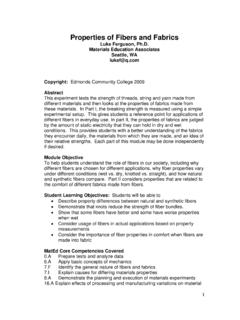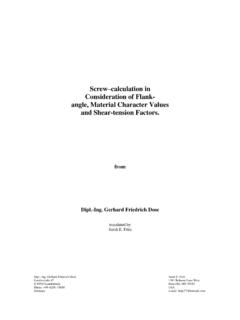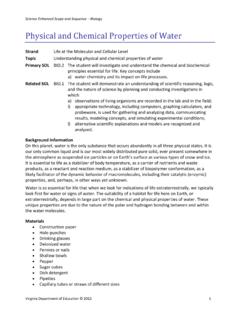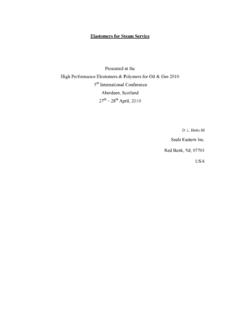Transcription of STUDIES ON THEEFFECT OF FERMENTED CORTEX …
1 Open Access Journal International Journal of Medical Research and Pharmaceutical Sciences Volume 3 (Issue 12) : December 2016 ISSN: 2394-9414. DOI: 105281 Impact Factor- STUDIES ON THEEFFECT OF FERMENTED CORTEX RESIDUEOF. ALOE AS FOOD ADDITIVES ON PIG'S MEAT QUALITY. Won-Sik Choi*1, Pandu Sandi Pratama2, Sun-Mi Choi1, Teak-Soon Shin3. *1,2. Department of Bio-Industrial Machinery Engineering, Pusan National University, Republic of Korea 3. Department of Animal Science, Pusan National University, Republic of Korea Abstract In this study, the feasibility of using Aloe saponaria species CORTEX residues as a Keywords: dietary supplement for pigs by feeding the aloe fermentation treatments was Aloe Saponaria, groups of pigs were became a subject in this research. One group of Fermentation, Food pigs was fed by diets food containing general food and the other group was fed by additive, Pig's growth, diets food containing FERMENTED diet food was fed once every 10 days up to Meat 70 days, and then once every 20 days up to 152 day.
2 In the end of experimental period, the meat qualityof both groups was analyzed. The storage weight lossat 4 1. , pH, water retention, and flesh colorwere measured. The experimental results shows that the meat quality of pigs fed by FERMENTED aloe is similar with the pigs fed by general food. Therefore, the FERMENTED Aloe saponaria CORTEX residues could be an alternative solution for dietary supplement food. INTRODUCTION. Aloe has been used as an important medicinal herb in the world since many centuries. The history shows that Aloe has been a favorite medical herb in the Ephrus papyrus in the 15th century BC and in Greecein the 4th century BC. Aloe belongs to the Asparagales order,Asphodelaceae family, Asphodeloideae subfamily, and monocots plant. In Korea, interest in Aloe has increased, and it is mainly used as a healthy food for improvement health , Aloe has widened its range of use on the healthy food and skin beauty.
3 Aloe can be divided into three parts such as a CORTEX , a yellow fluid layer and a gel layer. The yellow fluid layer has an anthraquinone and chromium effective ingredients. The thick gel layer called aloe flesh is composed of polysaccharides and glycoproteins. It also contains active ingredients and minerals. Gel layer is mainly used as raw materials of medicines and cosmetics. After extracting the inside of the aloe leaf, a large amount of CORTEX part of the aloe leaves rich in dietary fiber, cellulose, and minerals should be recycled. To solve this problem, this paper investigates the feasibility of using Aloe saponaria species CORTEX residues as a dietary supplement for pigs. Aloe saponaria fermentation could be an alternatives solution to improve the economic value of aloe waste. MATERIAL & METHOD. Material In the beginning of experiment, 120 piglets were selected in the farm and the piglets were divided into two groups.
4 One group was fed by diets food containing general food and the other group fed by diets food containing FERMENTED diet food was fed once every 10 days up to 70 days, and then once every 20 days up to 152 day. Method After completion of the experiment period, the results were checked and the gradeswere determined by livestock product quality assurance picking the grade, the fresh fillet muscle were stored immediately at the 48. International Journal of Medical Research and Pharmaceutical Sciences Open Access Journal International Journal of Medical Research and Pharmaceutical Sciences Volume 3 (Issue 12) : December 2016 ISSN: 2394-9414. DOI: 105281 Impact Factor- refrigeration temperature (4 1 ), and shipped to animal husbandry laboratory at Busan National University. Then the meat quality such as storage weight lossat 4 1 , pH, water retention, and flesh colorwere measured. 1) pH. 10g of pork samples were homogenized with 90 ml of distilled water at 14,000 rpm for 2 minutes using a homogenizer and measured with a pH meter (Seven Easy pH, Mettler-toledo, Switzerland).
5 2) Storage weight losses The storage weight losses was measured by cutting the sirloin 680 ~ 720g and wrapping them with 3 laps wrapped to measure the weight decreasing due to the juice produced during the storage period at the refrigerating temperature of 4 1 . 3) Water retention The water retentivity was obtained by uniformly grinding and mixing the samples, placing them in a wire mesh and centrifuge tube, sealing them, placing the centrifuge tube in a B chi heating bath B-490, heating at 70 C for 30. minutes, cooling for 10 minutes, centrifuging at 100 rpm for 10 minutes (Centrifuge Union 5KR).The amount of water measured is called F (%).The sample is divided into the same amount and size, and then dried at 100 ~ 102 C. (Forced convection drying oven C-DF). The amount of water obtained by measuring the weight after cooling was calculated as W (%).The water retention can be calculated according to the following equation: W % F(%).
6 W. H. C % = W (%) x100(1). 4) Shear value Shear coolers were prepared in the size of 1cm 3cm and stored on a rack of an Instron universal testing machine (TT42R, Instron, USA). The stretching and load of the tensile tester were zeroed and the pressure and tension of the force or energy values involved in the interaction were measured. The shear value was measured using Warner- Bratzler at a test speed of 100 mm/min. 5) Meat color The meat color samples were measured by cutting the sample and measured using a Chromameter (CR 301, Minolta Co, Japan) and the CIE (Commission Internationalized Leclairage) L* value indicating the lightness and the redness. The CIE a* value and the CIE b* value indicating yellowness were repeatedly measured three times. At this time, the standardization work was normalized to Y = , x = , y = using the punching plate No. 12633117. RESULTS AND DISCUSSION. 1) pH. Table 1 shows the results of pH measurement of sirloin from pigs fed with and without pH of the control did not show any significant change over the storage period.
7 However, the pH of the experimental group tended to gradually increase with the storage period. There was a significant difference (p < ) between the experimental value of 1 day and the measurement value of 6 and 15 days (p < ). But there was no significant difference on the other days. The pH of control and experimental group did not show significant difference in the same storage period. As a result, in the experimental group, the measured values were significantly increased around 15 days, but the control and experimental groups showed only slight increase with the lapse of storage period. It can be said that there is no significant difference. 49. International Journal of Medical Research and Pharmaceutical Sciences Open Access Journal International Journal of Medical Research and Pharmaceutical Sciences Volume 3 (Issue 12) : December 2016 ISSN: 2394-9414. DOI: 105281 Impact Factor- Table 1. Changes in pH of longissimusdorsi from pigs fed different feeds during storage periods at 4 1 C.
8 Storage periods (days). Treatments1). 1 3 6 9 12 15. C T A ~ B: Means with different superscript in the same row are significantly different(p< ). 1) C: Pork feds without FERMENTED aloe feed, T: Pork feds with FERMENTED aloe feed. After slaughter, glycogen in the muscle is anaerobically metabolized and accumulation of lactic acid lowers the pH. of the muscle. The post-slaughtering temperature and the speed of the process tend to be proportional. In general, the pH of muscle after slaughter has dropped to pH within 24 hours (Penny, 1977), and the pH and descent rate of the conductor have been reported to affect other physicochemical properties such as water holding capacity and meat color (Briskey, 1964; Boles , 1993). In addition, it has been reported that the pH is increased by the proteolytic enzyme during fermentation (Boakye, 1993), and the same results were obtained on the 1st and 15th days in this study. As a result of this experiment, the change of pH according to the storage period is not significant, but the whole interval stays within the range of minimum to maximum , which is similar to the pH value of fresh meat.
9 The FAO also stated that the pH of pork fresh meat was to , which means that the samples used in the experiment, even after 15 days of storage can be used for food. In addition, the pH value increased from and at the end of storage period to at each storage period. 2) Storage weight losses Table 2 shows the results of the juice loss of the sirloin obtained from the pigs fed with and without loss was about 4% after 3 days of storage, steadily increased with the passage of time, and increased to at 15. days. In both control and experimental groups, there was a significant difference (p < ) between 1 and 3 days, but this was due to the absence of juice loss at the start of the experiment. There was no significant difference between the control and experimental measurements in the same storage period, which means that both the pigs fed with the aloe supplement and the pigs fed without aloe had no difference in juice loss over time.
10 Table 2. Changes in drip loss of longissimusdorsi from pigs fed different feeds during storage periods at 4 1 (%). Storage periods (days). Treatments1). 1 3 6 9 12 15. C 0B T 0B A ~ B: Means with different superscript in the same row are significantly different (p< ). 1) C: Pork feds without FERMENTED aloe feed, T: Pork feds with FERMENTED aloe feed. Meat juice loss is influenced by water conservatism. Hamm (1974) reported that the decrease in pH decreased the space between muscle fibers and decreased the water holding capacity, resulting in an increase in juice loss. According to Kauffman (1986), water present in food is chemically bonded to other molecules tightly or loosely, or 50. International Journal of Medical Research and Pharmaceutical Sciences Open Access Journal International Journal of Medical Research and Pharmaceutical Sciences Volume 3 (Issue 12) : December 2016 ISSN: 2394-9414. DOI: 105281 Impact Factor- freely.







